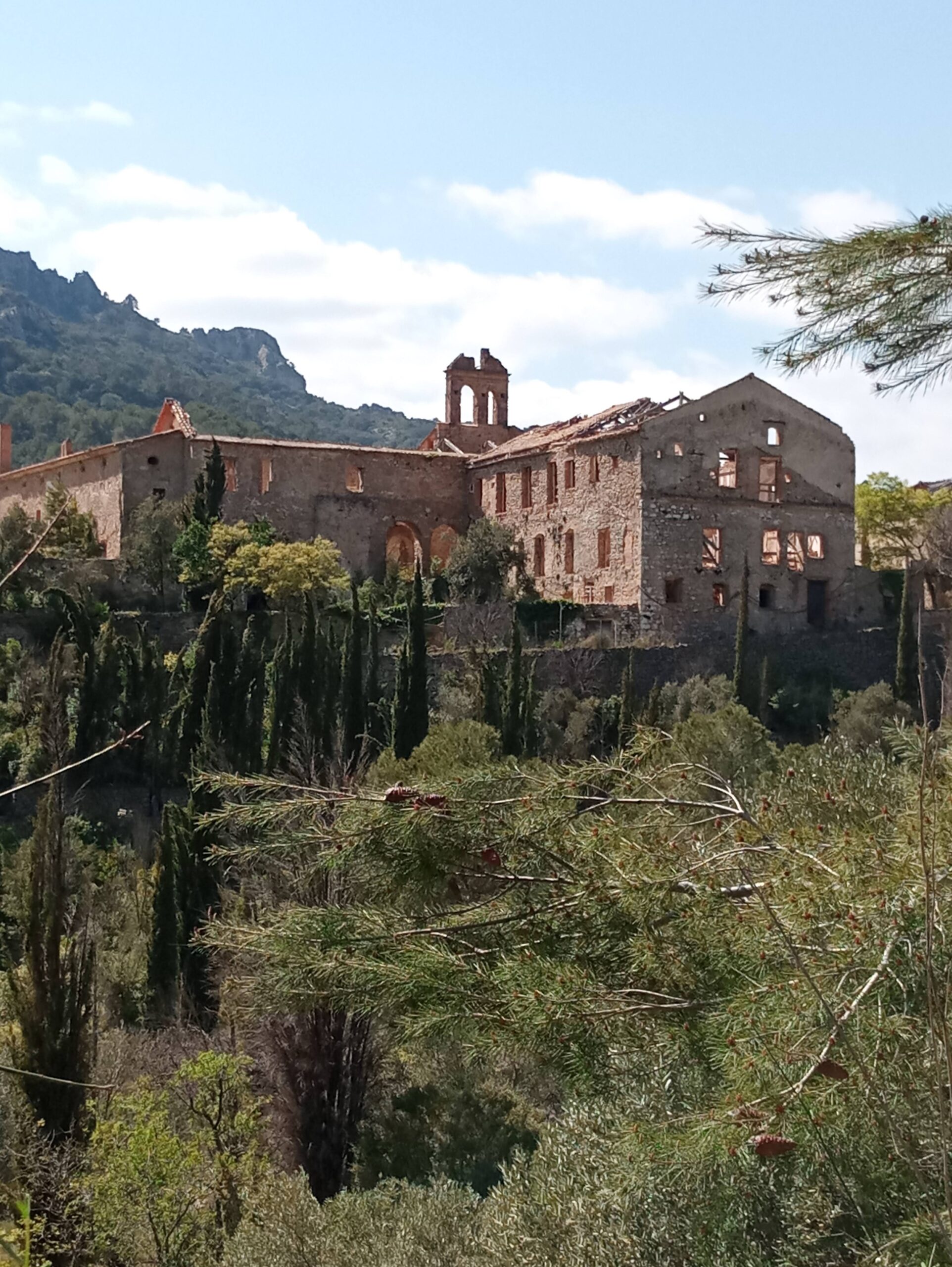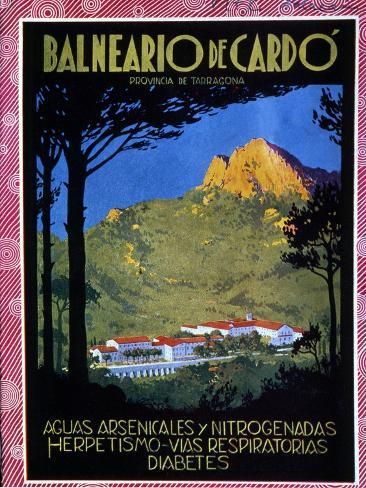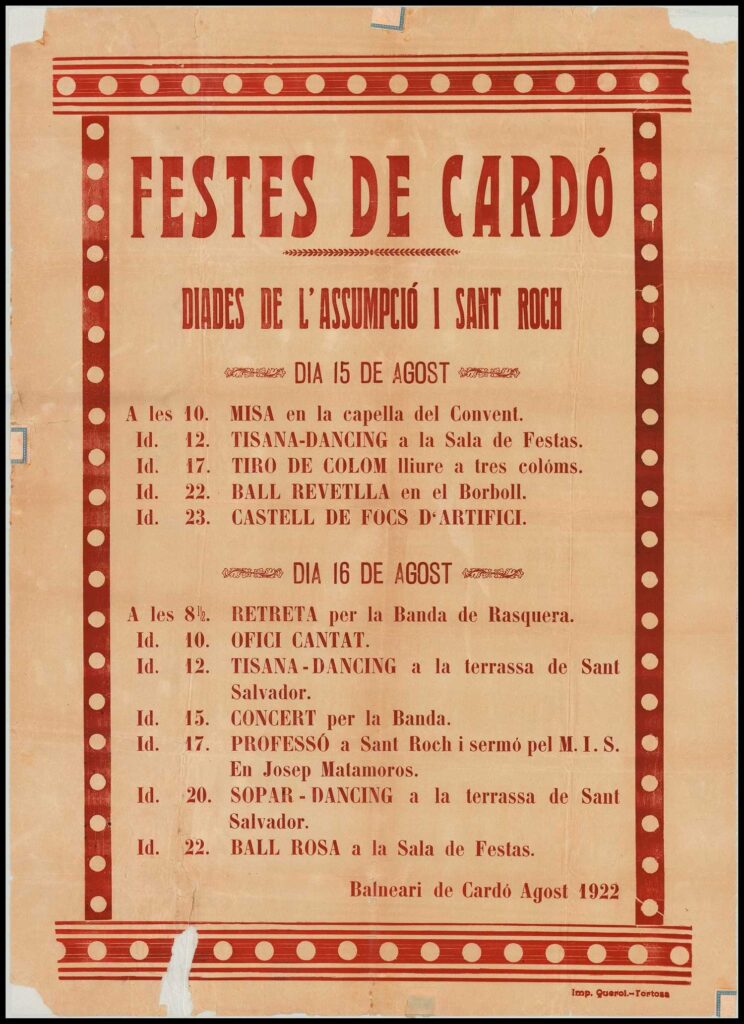OLD SPA OF CARDÓ
History of the Spa
The Carmelite Order, established in Spain by Saint Teresa of Jesus, inspired the Fathers of the Church to found new monasteries of this reformed order. In addition, they organized an austere life, even building religious deserts in remote places and sending exclusively religious who requested it. At the beginning of the 17th century, fra Jeroni de l'Assumpció, recently appointed Prior of Tortosa, asked fra Pau de Crist (born in Gavadà, district of Vandellòs, with the name of Pere Pau Revull) to found a new hermitage in the area This synchronicity marked the beginning of the history of the Spa and Hermitage of Cardó, which has always captivated those who have admired its beauty. In 1605, Friar Pau de Crist decided to build a Carmelite hermitage in the Serra de Cardó.

During the Carlist war, the friars had to leave the monastery of Cardó, taking refuge in neighboring towns. This abandonment was made definitive with Mendizábal's confiscation decree of 1836. Part of Cardó was auctioned in 1844, and the monks' belongings were dispersed, including tapestries, books and valuables. Most of the books were burned. For two decades, Cardó was abandoned due to economic difficulties. In 1866, businessmen from Tortosa transformed the ruins of the monastery into a spa, taking advantage of the properties of its waters. They rehabilitated the outbuildings in better condition, but the property belonged to the State. In 1870, the State still owned the building, but José Monclús had acquired the adjacent farmland. In 1872, Salvador Cabestany Gasol and his uncle bought four properties in Cardó, including the monastery buildings, and in 1877 Cabestany was the sole owner. During this period, numerous renovations were made, converting the old church into a dining room and other cells into guest rooms. The central courtyard of the cloister was covered with crystals, and the church was transformed into a party hall. In 1883, Cabestany restored the buildings, turning them into a modern spa. A new chapel was built in 1884, a road in Tivenys in 1885, and a road in Tortosa in 1887. At the end of the 19th century, the spa gained fame, and in 1899 Cabestany promoted its development with the building of San Salvador. In 1902, construction began on a new road in Rasquera, inaugurated in 1904, which increased the number of visitors. With the death of Cabestany in 1912, the spa became the property of his children. During the CIVIL WAR of the 20th century, the Cardó Spa had three main roles:
- Place of rest and detention of the bishop of Tortosa: At the beginning of the military uprising, the spa was a place of rest. The bishop of Tortosa, Félix Bilbao, was on vacation there when the uprising began. A group of armed revolutionaries arrested him at the end of July and decided to take him to Tortosa, the seat of the bishopric. The mayor of Tortosa, Joan Berenguer Cros, tried to divert the convoy to Tarragona, but he did not succeed, and the bishop was made available to the Anti-Fascist Committee of Tortosa, which finally accepted the transfer to Tarragona, with the exception of the FAI.
- Refuge for civilians: The owner of the spa, Salvador Samsó, hung the French flag, indicating that the resort was under international jurisdiction, which deterred other revolutionary groups from acting violently. This allowed civilians, mainly from Benifallet, fleeing the ravages of war, to find safety in the spa. These civilians were kindly welcomed by the soldiers stationed at the site.
- Republican military hospital: At an undetermined time in 1938, the spa became a republican military hospital, operational during the Battle of the Ebro. The medical lieutenant Josep Maria Raméntol Rifà recounted the dangers of the access road for ambulances arriving at night. Avel·lí Artís-Gener (Tisner), a wounded soldier, was also admitted to the spa to recover from his wounds.
At the end of August 1938, the 45th International Division organized an event at the spa to recognize the unit's corporal school and introduce the new head of the 12th International Brigade 'Garibaldi', the Spaniard Luis Rivas Pereyra, who he replaced the Italian Alessandro Vaja ('Martino Martini'). The event had the participation of civilians and probably the mayor of Benifallet, who moved the council to the Balneari when the riots started in the town. Presentations of authorities, a lunch and parliaments were held, with the intervention of the commissar of the brigade, the Italian Emilio Suardi, and the presence of the head of the division, the German Hans Kahle. The chronicle of the event was published on September 7, 1938 in the newspaper of the International Brigades, "Il Volontario della Libertà". In 1940, Ricardo Viñas reopened the spa, investing in renovations such as the construction of a new dining room and the Plaça dels Lledoners. The spa had electric lighting, a tennis court, swimming pool, cinema and ballroom until it was abandoned in 1967. In 1974, Enric Nomen Borràs acquired the property and installed a water bottling plant. Later, Nestlé S.A., Abengoa S.A., and Leche Pascual acquired the property, starting transformations of the industrial complex, until bottling activity ceased in 2007. In the course of 2004, the owners of the Balneari de Cardó (Leche Pascual) started a new project: to turn the area into a luxury hotel/spa. It materialized in a first "Urgent Consolidation, Conservation and Demolitions Project in the Spa of Cardo". The first work began that same year and consisted of the sanitation of the entire area and the dismantling of the roofs of the complex. Unfortunately, the work was stopped at the end of that same year and at this time, it has not yet been restarted, which has caused the deterioration of the buildings to accelerate.
“From here we thank from the bottom of our hearts everyone who works so that the Spa of Cardó does not fall into oblivion. Your dedication is incredible and helps us to keep alive the history of this very special place. Thank you for everything do.”
Memories



Benifallet Tourism Office
Av. Lluís Companys, 6 – Benifallet
SCHEDULE
- LOW SEASON | From Monday to Friday, from 9 am to 2 pm.
- MIDDLE SEASON (Easter until Saint John) | From Monday to Friday, from 9 am to 2 pm. and weekends and holidays, 10 a.m. to 1:30 p.m. and 3:30 p.m. to 6:30 p.m.
- HIGH SEASON (June – September) | From Monday to Sunday, from 10 a.m. to 1:30 p.m. and from 3:30 p.m. to 6:30 p.m.
